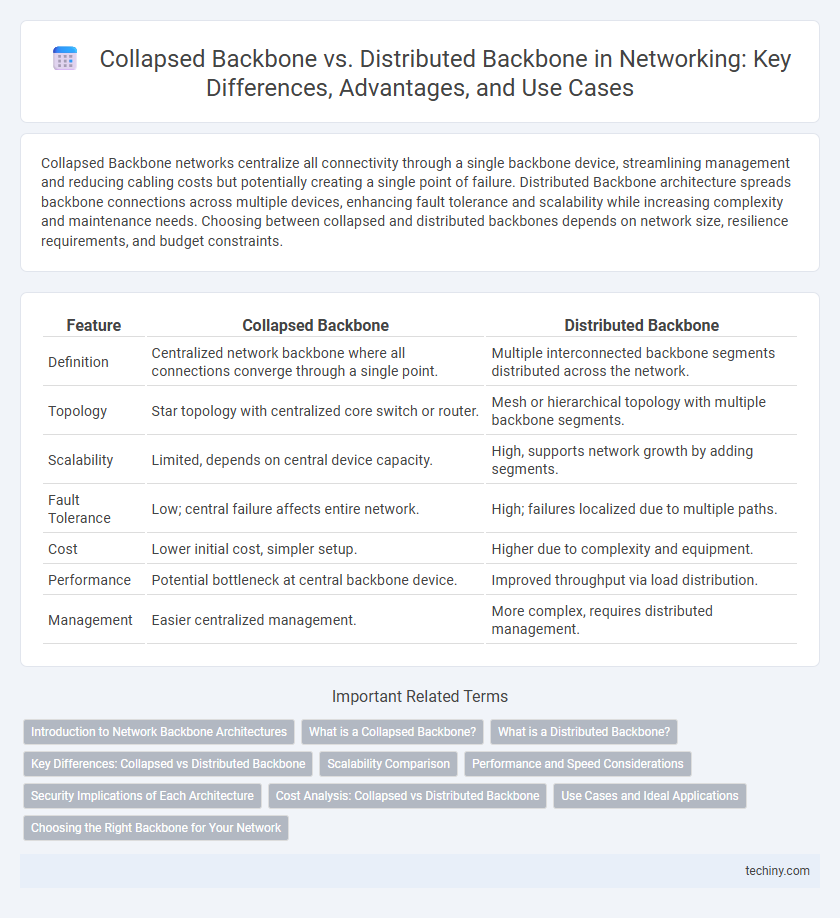Collapsed Backbone networks centralize all connectivity through a single backbone device, streamlining management and reducing cabling costs but potentially creating a single point of failure. Distributed Backbone architecture spreads backbone connections across multiple devices, enhancing fault tolerance and scalability while increasing complexity and maintenance needs. Choosing between collapsed and distributed backbones depends on network size, resilience requirements, and budget constraints.
Table of Comparison
| Feature | Collapsed Backbone | Distributed Backbone |
|---|---|---|
| Definition | Centralized network backbone where all connections converge through a single point. | Multiple interconnected backbone segments distributed across the network. |
| Topology | Star topology with centralized core switch or router. | Mesh or hierarchical topology with multiple backbone segments. |
| Scalability | Limited, depends on central device capacity. | High, supports network growth by adding segments. |
| Fault Tolerance | Low; central failure affects entire network. | High; failures localized due to multiple paths. |
| Cost | Lower initial cost, simpler setup. | Higher due to complexity and equipment. |
| Performance | Potential bottleneck at central backbone device. | Improved throughput via load distribution. |
| Management | Easier centralized management. | More complex, requires distributed management. |
Introduction to Network Backbone Architectures
Collapsed backbone architecture centralizes core network functions in a single device or location, simplifying management but creating a potential bottleneck and single point of failure. Distributed backbone architecture distributes these core functions across multiple devices or locations, enhancing scalability and fault tolerance by reducing congestion and improving redundancy. Choosing between collapsed and distributed backbones depends on factors such as network size, performance requirements, and reliability needs in enterprise or campus network designs.
What is a Collapsed Backbone?
A collapsed backbone is a centralized network design where all backbone connections converge at a single core device, typically a high-capacity switch or router, streamlining traffic management and reducing cabling complexity. This model enhances network performance by simplifying administration and improving scalability through a robust, centralized infrastructure. Collapsed backbones are ideal for environments requiring efficient data flow and centralized control, minimizing latency and potential points of failure.
What is a Distributed Backbone?
A distributed backbone is a network topology where multiple backbone segments are interconnected to enhance scalability and fault tolerance across a larger geographic area. Unlike a collapsed backbone, which centralizes network traffic through a single point, a distributed backbone spreads traffic load, improving performance and reducing single points of failure. This design supports modular growth and simplifies troubleshooting in complex enterprise networks.
Key Differences: Collapsed vs Distributed Backbone
A collapsed backbone centralizes network traffic through a single core device or switch, optimizing management and reducing hardware costs but creating a potential bottleneck or single point of failure. In contrast, a distributed backbone spreads traffic across multiple interconnected backbone devices, enhancing scalability, redundancy, and fault tolerance for larger or more complex networks. Key differences include centralized control and cost efficiency in collapsed backbones versus improved fault tolerance and scalability in distributed backbones.
Scalability Comparison
A collapsed backbone architecture centralizes network traffic through a single core device, which can create scalability limitations as network size and data load increase. In contrast, a distributed backbone uses multiple interconnected devices to handle traffic, enabling better scalability by distributing the load and reducing bottlenecks. Enterprises experiencing rapid growth often prefer distributed backbones for scalable network expansion and improved fault tolerance.
Performance and Speed Considerations
Collapsed backbone architecture centralizes network traffic through a single backbone device, potentially creating a bottleneck and limiting performance during peak usage. Distributed backbone topology spreads the load across multiple interconnected backbone devices, enhancing speed and reliability by reducing congestion and allowing parallel data transmission paths. Network environments demanding high throughput and low latency typically benefit from distributed backbones due to their scalable and fault-tolerant design.
Security Implications of Each Architecture
Collapsed backbone architecture centralizes network traffic through a single core switch or router, increasing vulnerability to targeted attacks and single points of failure. Distributed backbone architecture segments the network across multiple interconnected devices, enhancing security by isolating threats and reducing the risk of widespread compromise. Implementing robust access controls and segmentation strategies in distributed backbones further mitigates potential attack surfaces compared to the collapsed backbone approach.
Cost Analysis: Collapsed vs Distributed Backbone
A collapsed backbone network typically incurs lower initial costs due to centralized equipment and reduced cabling requirements, making it cost-effective for small to medium-sized organizations. Distributed backbone architecture, while resulting in higher upfront investment from multiple backbone segments and increased hardware, offers scalability and fault tolerance ideal for large or geographically diverse networks. Over time, distributed backbones may lower maintenance expenses through modular upgrades and localized troubleshooting, balancing the higher installation costs.
Use Cases and Ideal Applications
Collapsed backbone architecture is ideal for small to medium-sized networks where simplicity and cost-effectiveness are priorities, such as in small office environments or branch offices. Distributed backbone design suits large enterprise networks requiring scalability and fault tolerance, commonly used in campus networks or data centers. Use cases for distributed backbones emphasize high traffic loads and redundancy, while collapsed backbones favor ease of management and reduced hardware complexity.
Choosing the Right Backbone for Your Network
Choosing the right backbone for your network involves evaluating factors like scalability, cost, and fault tolerance. A collapsed backbone consolidates core network functions into a centralized device, optimizing management and minimizing cabling costs, ideal for smaller networks. In contrast, a distributed backbone uses multiple interconnected devices to enhance redundancy and support larger, geographically dispersed networks with increased fault tolerance.
Collapsed Backbone vs Distributed Backbone Infographic

 techiny.com
techiny.com